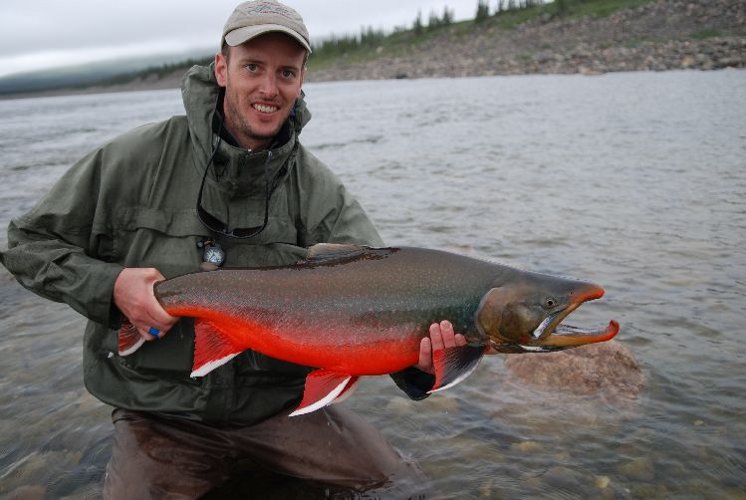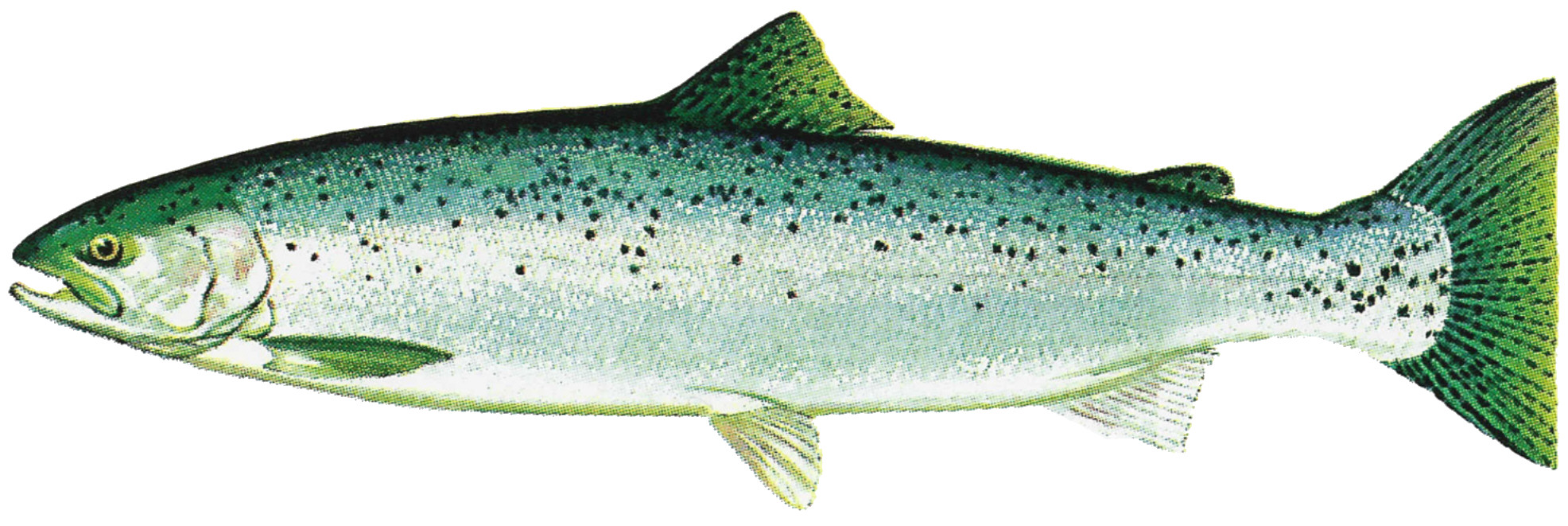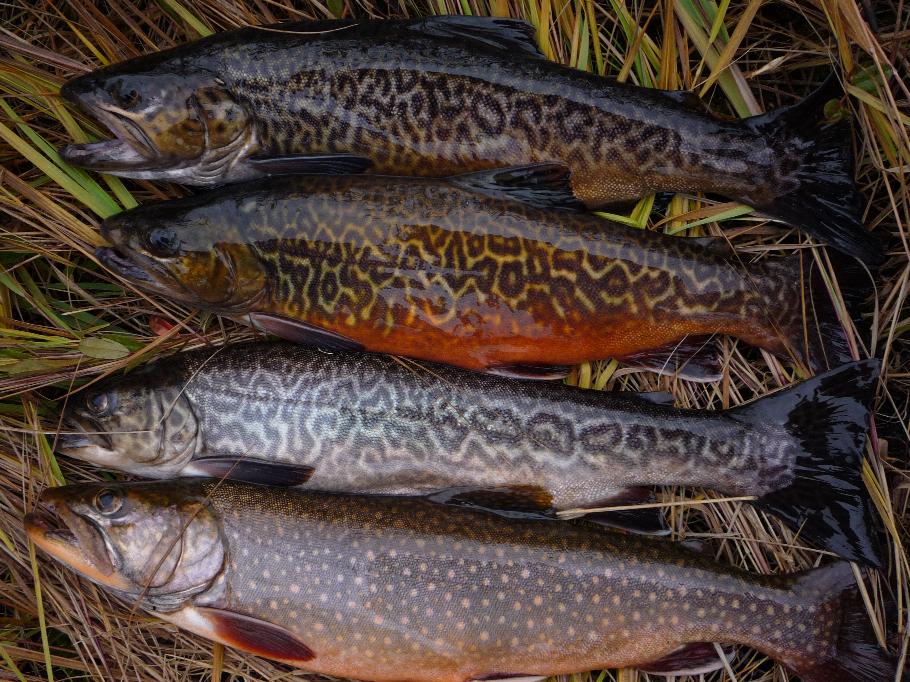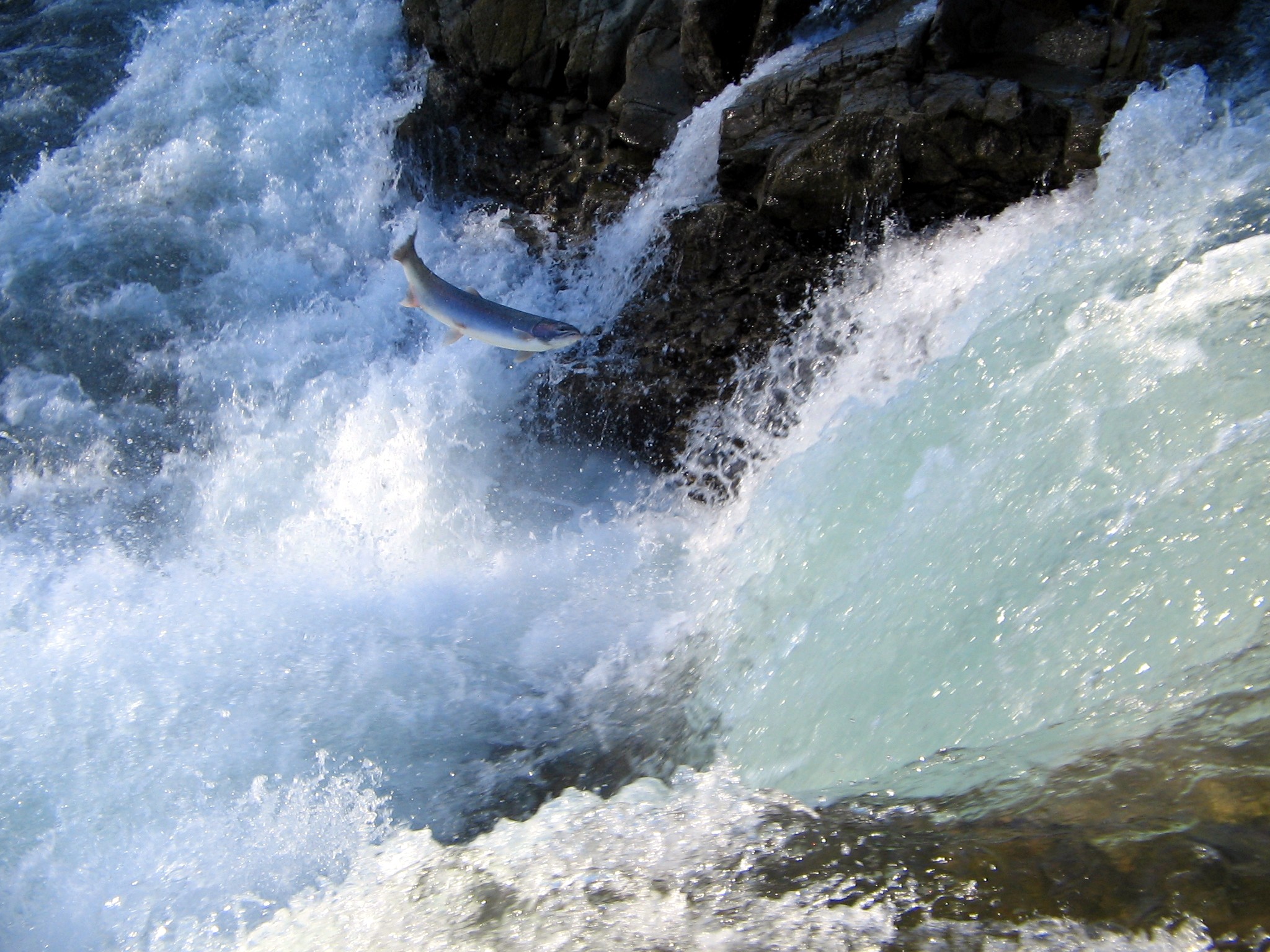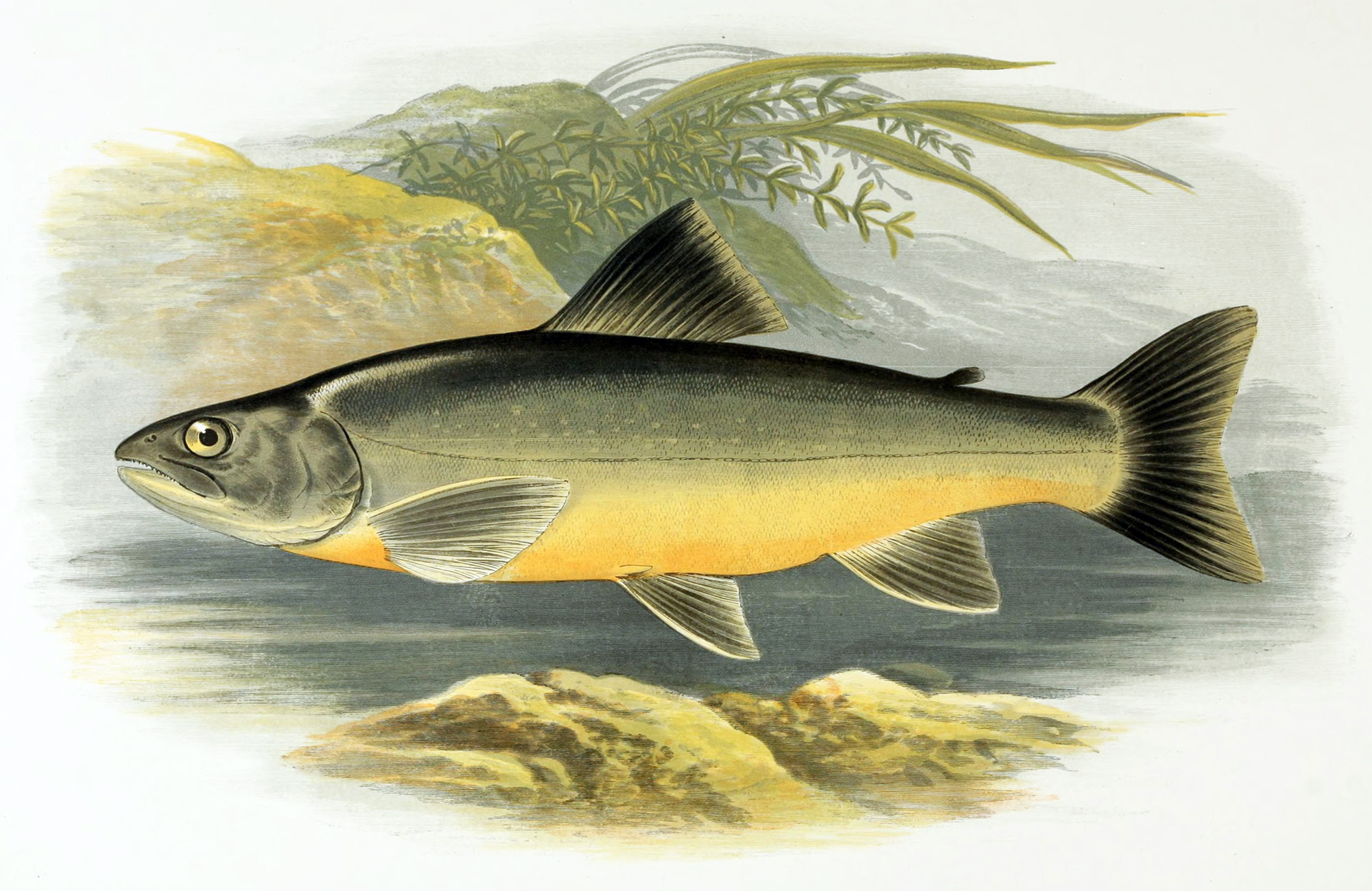|
Kype
A kype is a hook-like secondary sex characteristic which develops at the distal tip of the lower jaw in some male salmonids prior to the spawning season. The structure usually develops in the weeks prior to, and during, migration to the spawning grounds. In addition to the development of the kype, a large depression forms in the two halves of the premaxilla in the upper jaw, allowing the kype to fit into the premaxilla when the mouth is closed. The kype functions as a secondary sexual characteristic and influences the formation of dominance hierarchies at the spawning grounds. The size of the kype is believed to determine male spawning frequency. Description The kype grows rapidly from bony needles proliferating from the tip of the dentary (the anterior and largest of the bones making up the lower jaw). The needles form a mesh, but do not interfere with the connective tissues used by bone marrow. At the snout, the needles strengthen into Sharpey's fibres. The speed at which the k ... [...More Info...] [...Related Items...] OR: [Wikipedia] [Google] [Baidu] |
Oncorhynchus
''Oncorhynchus'', from Ancient Greek ὄγκος (''ónkos''), meaning "bend", and ῥύγχος (''rhúnkhos''), meaning "snout", is a genus of ray-finned fish in the subfamily Salmoninae of the family (biology), family Salmonidae, native to coldwater tributaries of the North Pacific basin. The genus contains twelve extant taxon, extant species, namely six species of Pacific salmon and six species of Pacific trout, all of which are fish migration, migratory (either anadromous or potamodromous) mid-trophic level, level predatory fish that display natal homing and semelparity. The name of the genus is derived from Ancient Greek ὄγκος (''ónkos''), meaning "bend", and ῥύγχος (''rhúnkhos''), meaning "snout", in reference to the hooked secondary sexual characteristic — known as the kype — that the males develop on the lower jaw tip during mating season. Range Salmon and trout within ''Oncorhynchus'' are native to the tributaries of the North Pacific Ocean, with th ... [...More Info...] [...Related Items...] OR: [Wikipedia] [Google] [Baidu] |
Arctic Char
The Arctic char or Arctic charr (''Salvelinus alpinus'') is a cold-water fish in the family Salmonidae, native to alpine lakes, as well as Arctic and subarctic coastal waters in the Holarctic realm, Holarctic. Distribution and habitat It Spawn (biology), spawns in freshwater and its populations can be lacustrine, riverine, or anadromous, where they return from the ocean to their fresh water birth rivers to spawn. No other freshwater fish is found as far north; it is, for instance, the only fish species in Lake Hazen, which extends up to on Ellesmere Island in the Northern Canada, Canadian Arctic. It is one of the rarest fish species in Great Britain and Ireland, found mainly in deep, cold, glacial lakes, and is at risk there from acidification. In other parts of its range, such as the Nordic countries, it is much more common, and is fishery, fished extensively. In Siberia, it is known as ''golets'' () and it has been introduced in lakes where it sometimes threatens less hardy ... [...More Info...] [...Related Items...] OR: [Wikipedia] [Google] [Baidu] |
Salmon
Salmon (; : salmon) are any of several list of commercially important fish species, commercially important species of euryhaline ray-finned fish from the genera ''Salmo'' and ''Oncorhynchus'' of the family (biology), family Salmonidae, native to tributary, tributaries of the North Atlantic (''Salmo'') and North Pacific (''Oncorhynchus'') basins. ''Salmon'' is a colloquial or common name used for fish in this group, but is not a scientific name. Other closely related fish in the same family include trout, Salvelinus, char, Thymallus, grayling, Freshwater whitefish, whitefish, lenok and Hucho, taimen, all coldwater fish of the subarctic and cooler temperate regions with some sporadic endorheic populations in Central Asia. Salmon are typically fish migration, anadromous: they hatch in the shallow gravel stream bed, beds of freshwater headstreams and spend their juvenile fish, juvenile years in rivers, lakes and freshwater wetlands, migrate to the ocean as adults and live like sea ... [...More Info...] [...Related Items...] OR: [Wikipedia] [Google] [Baidu] |
Rainbow Trout
The rainbow trout (''Oncorhynchus mykiss'') is a species of trout native to cold-water tributary, tributaries of the Pacific Ocean in North America and Asia. The steelhead (sometimes called steelhead trout) is an Fish migration#Classification, anadromous (sea-run) form of the coastal rainbow trout or Columbia River redband trout that usually returns to freshwater to Spawn (biology), spawn after living two to three years in the ocean. Adult freshwater stream rainbow trout average between , while lake-dwelling and anadromous forms may reach . Coloration varies widely based on subspecies, forms, and habitat. Adult fish are distinguished by a broad reddish stripe along the lateral line, from gills to the tail, which is most vivid in breeding males. Wild-caught and Fish hatchery, hatchery-reared forms of the species have been transplanted and introduced for food or sport in at least 45 countries and every continent except Antarctica. Introductions to locations outside their nativ ... [...More Info...] [...Related Items...] OR: [Wikipedia] [Google] [Baidu] |
Atlantic Salmon Male (5198590554)
The Atlantic Ocean is the second largest of the world's five oceanic divisions, with an area of about . It covers approximately 17% of Earth's surface and about 24% of its water surface area. During the Age of Discovery, it was known for separating the New World of the Americas (North America and South America) from the Old World of Afro-Eurasia (Africa, Asia, and Europe). Through its separation of Afro-Eurasia from the Americas, the Atlantic Ocean has played a central role in the development of human society, globalization, and the histories of many nations. While the Norse were the first known humans to cross the Atlantic, it was the expedition of Christopher Columbus in 1492 that proved to be the most consequential. Columbus's expedition ushered in an age of exploration and colonization of the Americas by European powers, most notably Portugal, Spain, France, and the United Kingdom. From the 16th to 19th centuries, the Atlantic Ocean was the center of both an eponymous ... [...More Info...] [...Related Items...] OR: [Wikipedia] [Google] [Baidu] |
Large Male Arctic Char
Large means of great size. Large may also refer to: Mathematics * Arbitrarily large, a phrase in mathematics * Large cardinal, a property of certain transfinite numbers * Large category, a category with a proper class of objects and morphisms (or both) * Large diffeomorphism, a diffeomorphism that cannot be continuously connected to the identity diffeomorphism in mathematics and physics * Large numbers, numbers significantly larger than those ordinarily used in everyday life * Large ordinal, a type of number in set theory * Large sieve, a method of analytic number theory ** Larger sieve, a heightening of the large sieve * Law of large numbers, a result in probability theory * Sufficiently large, a phrase in mathematics Other uses * ''Large'' (film), a 2001 comedy film * Large (surname), an English surname * LARGE, an enzyme * Large, a British English name for the maxima (music), a note length in mensural notation * Large, or G's, or grand, slang for $1,000 US dollars * Large, ... [...More Info...] [...Related Items...] OR: [Wikipedia] [Google] [Baidu] |
Lake Trout
The lake trout (''Salvelinus namaycush'') is a freshwater Salvelinus, char living mainly in lakes in Northern North America. Other names for it include mackinaw, namaycush, lake char (or charr), touladi, togue, laker, and grey trout. In Lake Superior, it can also be variously known as siscowet, paperbelly and lean. The lake trout is prized both as a game fish and as a Fish as food, food fish. Those caught with dark coloration may be called ''mud hens''. Taxonomy and etymology It is the only member of the subgenus ''Cristovomer'', which is more derived than the subgenus ''Salvelinus#Taxonomy, Baione'' (the most Basal (phylogenetics), basal clade of ''Salvelinus'', containing the brook trout (''S. fontinalis'') and silver trout (''S. agasizii'')) but still basal to the other members of ''Salvelinus''. The binominal nomenclature, specific epithet ''namaycush'' derives from ''namekush'', a form of the word used in some inland Southern East Cree language, Southern East Cree commun ... [...More Info...] [...Related Items...] OR: [Wikipedia] [Google] [Baidu] |
Brook Trout
The brook trout (''Salvelinus fontinalis'') is a species of freshwater fish in the char genus ''Salvelinus'' of the salmon family Salmonidae native to Eastern North America in the United States and Canada. Two ecological forms of brook trout have been recognized by the US Forest Service. One ecological form is long-lived potamodromous populations in Lake Superior known as coaster trout or coasters. The second ecological form is the short-living predaceous anadromous populations which are found in northern lakes and coastal rivers from Long Island to Hudson Bay, which are referred to as salters. In parts of its range, it is also known as the eastern brook trout, speckled trout, brook char (or charr), squaretail, brookie, or mud trout, among others. Adult coaster brook trout are capable of reaching sizes over 2'' ''feet in length and weigh up to 6.8'' ''kg (15'' ''lb), whereas adult salters average between 6 and 15'' ''inches in length and weigh between 0. ... [...More Info...] [...Related Items...] OR: [Wikipedia] [Google] [Baidu] |
Dolly Varden Trout
The Dolly Varden trout (''Salvelinus malma'') is a species of salmonid ray-finned fish native to cold-water tributaries of the Pacific Ocean in Asia and North America. Despite the name "trout" (which typically refers to freshwater species from the genera ''Salmo'' and ''Oncorhynchus''), it belongs to the genus ''Salvelinus'' (chars), which includes 51 recognized species, the most prominent being the brook, lake and bull trout as well as the Arctic char. Although many populations are semi-anadromous, riverine and lacustrine populations occur throughout its range. It is considered by taxonomists as part of the ''Salvelinus alpinus'' (Arctic char) complex, as many populations of bull trout, Dolly Varden trout and Arctic char overlap. Taxonomy The scientific name of the Dolly Varden is ''Salvelinus malma''. The species was originally named by German naturalist and taxonomist Johann Julius Walbaum in 1792 based on type specimens from the Kamchatka Peninsula in Siberia. The name '' ... [...More Info...] [...Related Items...] OR: [Wikipedia] [Google] [Baidu] |
Anadromous
Fish migration is mass relocation by fish from one area or body of water to another. Many types of fish migrate on a regular basis, on time scales ranging from daily to annually or longer, and over distances ranging from a few metres to thousands of kilometres. Such migrations are usually done for better feeding or to reproduce, but in other cases the reasons are unclear. Fish migrations involve movements of schools of fish on a scale and duration larger than those arising during normal daily activities. Some particular types of migration are ''anadromous'', in which adult fish live in the sea and migrate into fresh water to spawn; and ''catadromous'', in which adult fish live in fresh water and migrate into salt water to spawn. Marine forage fish often make large migrations between their spawning, feeding and nursery grounds. Their movements are associated with ocean currents and with the availability of food in different areas at different times of the year. The migratory ... [...More Info...] [...Related Items...] OR: [Wikipedia] [Google] [Baidu] |
Bull Trout
The bull trout (''Salvelinus confluentus'') is a char of the family Salmonidae native to northwestern North America. Historically, ''S. confluentus'' has been known as the " Dolly Varden" (''S. malma''), but was reclassified as a separate species in 1980. Populations of bull trout in the lower 48 states are listed as threatened under the U.S. Endangered Species Act, and bull trout overall are listed as vulnerable to extinction on the IUCN Red List of Threatened Species. The Saskatchewan-Nelson Rivers population in Alberta, Canada is listed as threatened under the Species at Risk Act. Description Like other species of char, the fins of a bull trout have white leading edges. Its head and mouth are unusually large for salmonids, giving it its name. Bull trout have been recorded measuring up to in length and weighing . Bull trout may be either migratory, moving throughout large river systems, lakes, and the ocean, or they may be resident, remaining in the same stream their entir ... [...More Info...] [...Related Items...] OR: [Wikipedia] [Google] [Baidu] |
Salvelinus
''Salvelinus'' is a genus of Salmonidae, salmonid fish often called char or charr; some species are called "trout". ''Salvelinus'' is a member of the subfamily Salmoninae within the family Salmonidae. The genus has a northern circumpolar distribution, and most of its members are typically cold-water fish that primarily inhabit fresh waters. Many species also migrate to the sea. Most char may be identified by light-cream, pink, or red spots over a darker body. Scales tend to be small, with 115–200 along the lateral line. The pectoral, pelvic, anal, and the lower aspect of caudal fins are trimmed in snow white or cream leading edges. Many members of this genus are popular sport fish, and a few, such as lake trout (''S. namaycush'') and arctic char (''S. alpinus'') are objects of commercial fisheries and/or aquaculture. Occasionally such fish escape and become invasive species. Deepwater char are small species of char living below 80 m in the deep areas of certain lakes. They ar ... [...More Info...] [...Related Items...] OR: [Wikipedia] [Google] [Baidu] |
